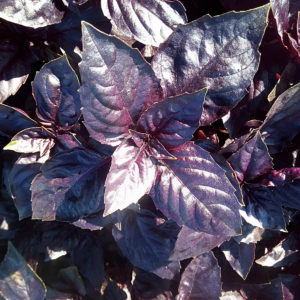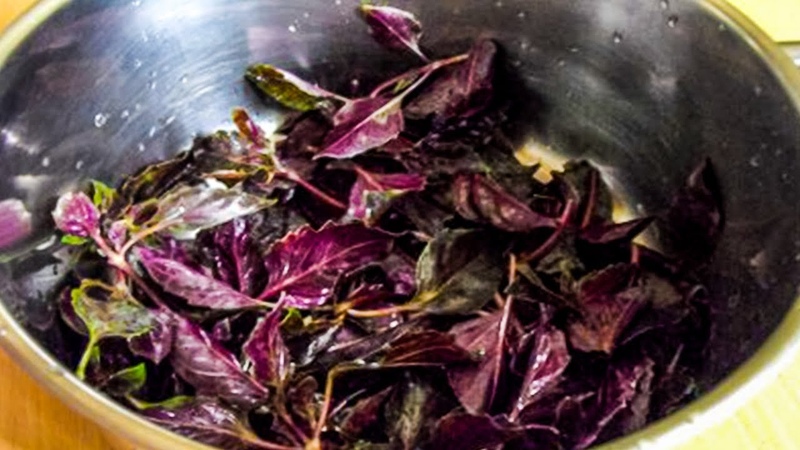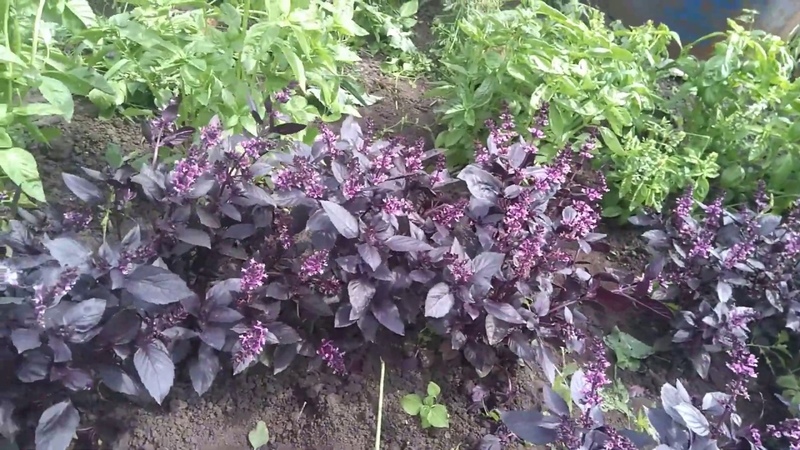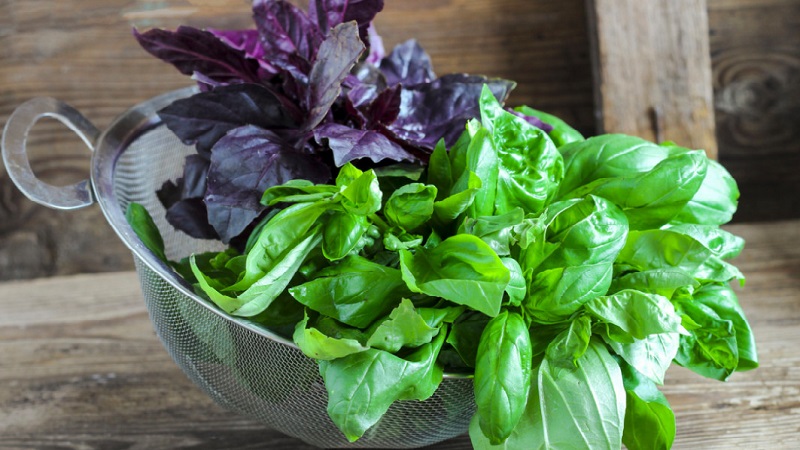Fast growing Rosie basil with excellent taste and aroma
The juicy and savory Rosie Basil is a great addition to any meal. This spice has gained such great popularity that it is found as the main component even in desserts. This love is due to the amazing properties of basil - it perfectly sets off tastes and gives piquant notes to ready-made culinary masterpieces.
The main advantage of the Rosie Basilica is its relative simplicity. You can even grow this spice in your home garden, if you know some of the intricacies of care.
The content of the article
Features of the variety

Rosy variety is focused mainly on professional cultivation. However, this plant perfectly adapts to home conditions, giving a stable harvest.
Rosie is one of the most common varieties that can be found in gardens and vegetable gardens today.... The plant has a rich purple color. The sizes are compact, the stem is dense and juicy. The leaves do not lose their color intensity even when grown in pots during winter. Rosie's Basil has a fast and active growth rate, for which farmers love it very much.
History of origin and distribution
Rosie is of Dutch descent. This plant came to Russia only in the 18th century. At first it was used as a medicinal plant for the treatment of infectious diseases, liver and digestive system pathologies. The taste characteristics of basil were not considered during this period.
Today Rosie's basil is recommended for cultivation throughout Russia. Occurs in the middle lane, in areas that are protected from northern winds.
In 2010, Rosie's Basil was officially included in the State Register. It happened on the initiative of "Enza Zaden" - the originator of the well-known seed company.
Differences from other varieties
Rosie's Basil is a favorite of professionals and novices in the agricultural business. The variety has a number of individual characteristics that distinguish it from other species, namely:
- Fast growth... Ripens within 38-40 days.
- Minimal care. Requires optimal temperature and humidity.
- Stability. Purple basil better than others withstands strong gusts of wind, rain, insignificant temperature changes.
Feature and Description
Rosy is a robust plant with a total height of 40 to 60 cm, with intensive branching. The leaves are large, oval in shape, with small notches along the edges. The color of the plant is dark purple, green blotches are absent. The average weight of one bush is 210 g.
Chemical composition
The chemical composition of purple basil per 100 g:
- potassium - 295 mg;
- calcium - 177 mg;
- magnesium - 64 mg;
- sodium - 4 mg;
- phosphorus - 56 mg;
- sulfur - 31.5 mg;
- iron - 3.17 mg;
- manganese - 1.148 mg;
- zinc - 0.81 mg;
- copper - 385 mcg;
- selenium - 0.3 mcg;
- vitamin C - 18 mg;
- A - 264 mg;
- E - 0.8 mg;
- B1 - 0.034 mg;
- B2 - 0.076 mg;
- B4 11.4 mg;
- B5 0.209 mg;
- B6 - 0.155 mg;
- B9 - 68 mcg.
Most of the oil is found in the fresh plant. Drying greatly reduces the yield of this nutrient.
Persistence
The plant does not tolerate sudden changes in temperature. Basil feels best at + 20 ... + 23 ° C.
Important! Some gardeners argue that basil can be hardened by artificially lowering the temperature during the period when the plant is just emerging. But the temperature must not be allowed to drop to + 5 ° C.
Rosie likes consistency, so temperature and humidity levels need to be stable. A change in the intensity of watering and temperature regime is detrimental to the plant. It loves abundant watering, but excessive waterlogging can lead to damage to the black leg.
Rosey Basil is resistant to many pests due to its chemical composition and persistent spicy aroma. However, some insects like to feast on the succulent leaves and stems of the plant.
Application area
Rosie's purple basil has a persistent peppery aroma and a lemon or anise flavor. It is consumed fresh and dried, used to prepare:
- salads;
- dishes of French, Caucasian, Armenian, Italian cuisines;
- canned food;
- drinks;
- balsamic vinegar.
Rosie is used in folk medicine. It tones, relieves pain and inflammation.
Advantages and disadvantages

Rosie's Basil has a number of benefits:
- 2.2 kg of finished crop;
- unpretentiousness;
- high resistance to disease;
- fast growth.
There are also a number of disadvantages:
- does not tolerate temperature changes;
- loves abundant watering (water it carefully so as not to flood the plant);
- cannot be grown in the same place.
Growing technology
Taking care of the plant is easy if you learn a few basic rules on which the yield of the spice depends.
Optimal conditions
Rosie loves open, well-fertilized areas. The soil should be breathable, not heavy. The best neighbors are tomatoes, eggplants, bell peppers.
The plant loves warmth. For seed germination, the optimum temperature is + 21 ... + 26 ° C, when planting in the ground - + 21 ... + 23 ° C.
Terms and rules of landing
Basil is planted after the last frost has passed - in early or mid June.
Important! Basil cannot be grown in the same place. This leads to depletion of the soil and a high incidence of plant diseases.
When landing, adhere to the following rules:
- They pre-dig up the ground, add 2 kg of humus, add compost and peat.
- Planted seedlings according to the scheme 30 × 30 cm.
- Landing carried out in the evening on a cloudy day.
- Then the plants are watered with warm, settled water.
Further care
The plant is watered abundantly once a week. It is better to take water that is settled, slightly warmed up.
Top dressing is necessary during the period of active growth. They use only natural fertilizers, avoiding growth enhancers - they have a detrimental effect on the chemical composition of the plant.
They are loosened after watering and rains to enrich the soil with oxygen and prevent the formation of an earth crust. It is also advisable to remove excess basil sprouts. The better the beds are thinned, the larger and more succulent the leaves will grow.
Important! Direct sunlight can negatively affect the growth of the basil. It is best to place the beds in the shade, close to trees or other plants.
Problems, diseases, pests

Rosie's basil is resistant to many diseases and pests. However, sometimes the stems and leaves infect aphids and field bugs.
Basil affected by aphids dries rapidly, the development of young shoots stops, and the existing leaves curl. Insects sit on stems and leaf plates in a dense layer. To combat aphids, wormwood, tansy decoction, tar soap, and wood ash are used.
If there are too many insects, chemical solutions are used: Karbofos, Bankol, Akarin, Aktellik. The drugs are used strictly according to the instructions.
The defeat of the basil by field bugs leads to deformation of the leaves. Spots of a characteristic white color appear on their surface. The leaves fall off and the root dies off. Both adult bugs and its larvae can cause harm. They fight the pest using folk methods and chemicals.
Despite its strong immunity, basil is subject to the following diseases:
- Fusarium. The fungus affects the vascular system of the plant. The top dries up and falls off. No treatment is possible. The only way out is to completely get rid of the infected plant.
- Blackleg - a fungal disease that appears due to excessive watering of the soil and improper care of the plant. The stem becomes soft and brittle, black and yellow rot spots appear. They fight blackleg with peat tablets, potassium permanganate solution, or any EM drug.
- Gray rot manifested by characteristic brown spots, which eventually become covered with a gray fluff. The disease affects the leaves of the basil, and then the whole bush. Chemical solutions are used for treatment.
Features of growing seeds / seedlings
And for seedlings, and the seeds require a temperature of at least + 20 ° C, abundant watering, sunlight, sufficient nutrients.
The only difference is that seedlings do not need special care at first. Seedlings require unquestioning compliance with all conditions at once.
In the ground, greenhouse, home
Rosie's Basil grows well in all conditions. However, in the greenhouse and at home, the chance of getting a rich harvest is much higher. This is achieved due to the constant temperature regime.
When planted in open ground, the basil may lack sunlight and heat. That is why it is recommended to plant the plant only when the probability of frost is excluded.
Reviews of summer residents

The Rosie variety is especially popular among summer residents today. Reviews testify to this.
Nikolay, Pskov: “I constantly grow greens in my garden. Recently, another spice has appeared on my beds - basil. At first I tried to plant different varieties, but then I settled on Rosie. It grows about 50 cm in length, has a beautiful purple color and a pleasant aroma with peppery notes. The variety does not require serious maintenance and at the same time gives a bountiful harvest. Perfectly complemented homemade pickles, I will definitely plant more. "
Svetlana, Kazan: “Before that, they planted Italian basil. This year I decided to try Rosie's basil. The taste was more intense. Became the main ingredient in the pesto sauce that I make for my family and the decoration of my garden, because it has such a beautiful purple hue. "
Conclusion
Rosie's basil is a real find for any gardener who is looking for a useful, beautiful and at the same time unpretentious spice to grow. When plants are planted in June and even early July, a rich harvest is harvested after 2 months.